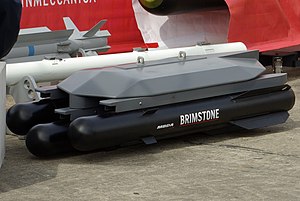Brimstone (missile)
| Brimstone | |
|---|---|

A triplet of single-mode Brimstone missiles
|
|
| Type | Air-to-surface missile |
| Place of origin | United Kingdom |
| Service history | |
| In service | 2005 |
| Used by |
Royal Air Force Royal Saudi Air Force |
| Wars |
Operation Telic Operation Herrick Operation Ellamy Operation Shader |
| Production history | |
| Designer | GEC-Marconi |
| Designed | 1996 |
| Manufacturer | MBDA (UK) Ltd, Henlow |
| Unit cost | (Dual Mode Variant) £105,000/unit £175,000 inc development |
| Produced | 1999 |
| Variants | Single mode Dual Mode Sensor Brimstone 2 |
| Specifications | |
| Weight | 107 lb (48.5 kg) |
| Length | 71 in (1,800 mm) |
| Diameter | 7.0 in (178 mm) |
| Warhead | HEAT tandem warhead |
|
Detonation
mechanism |
Crush (impact) fuze |
|
|
|
| Engine | Solid-fuel rocket |
|
Operational
range |
Brimstone I: 60+ km (37+ mi) from fixed wing, 40+ km (25+ mi) from rotor wing |
| Speed | Supersonic (~450m/s) |
|
Guidance
system |
94 GHz millimetric wave Active radar homing and INS autopilot, dual-mode adds laser guidance Accuracy = sub-1m CEP |
|
Steering
system |
Flight control surfaces |
|
Launch
platform |
Tornado GR4 Typhoon (planned) Reaper (planned) Protector (planned) Apache (planned) |
| Images | |
|---|---|
|
|
|
|
|
|
| Video | |
|
|
Brimstone I:
20+ km (12+ mi) from fixed wing, 12 km (7.5 mi) from rotor wing
Brimstone is an air-launched ground attack missile developed by MBDA for Britain's Royal Air Force. It was originally intended for "fire-and-forget" use against mass formations of enemy armour, using a millimetric wave (mmW) active radar homing seeker to ensure accuracy even against moving targets. Experience in Afghanistan led to the addition of laser guidance in the dual-mode Brimstone missile, allowing a "spotter" to pick out specific targets when friendly forces or civilians were in the area. The tandem shaped charge warhead is much more effective against modern tanks than older similar weapons such as the AGM-65G Maverick, while the small blast area minimises collateral damage. Three Brimstones are carried on a launcher that occupies a single weapon station, allowing a single aircraft to carry many missiles.
After a protracted development programme, single-mode or "millimetric" Brimstone entered service with RAF Tornado aircraft in 2005, and the dual-mode variant in 2008. The latter has been extensively used in Afghanistan and Libya. An improved Brimstone 2 was expected to enter service in October 2012, but problems with the new warhead from TDW and the ROXEL rocket motor put back the planned date to November 2015. MBDA is working on the targeting of swarms of small boats under the name Sea Spear. The RAF intend to fit Brimstone to their Eurofighter Typhoons, and planned to integrate it with their Harriers until the latter were withdrawn from service in 2011. MBDA is studying the use of Brimstone on ships, attack helicopters, UAVs, and from surface launchers. However, it will not be integrated on the Lockheed Martin F-35 Lightning II. The United States, France and India have expressed interest in buying Brimstone for their aircraft, but Saudi Arabia is the only export customer as of 2015[update]. The cost per missile has been quoted as £175,000 ($263,000) each in 2015, or 'over £100,000'.
...
Wikipedia
